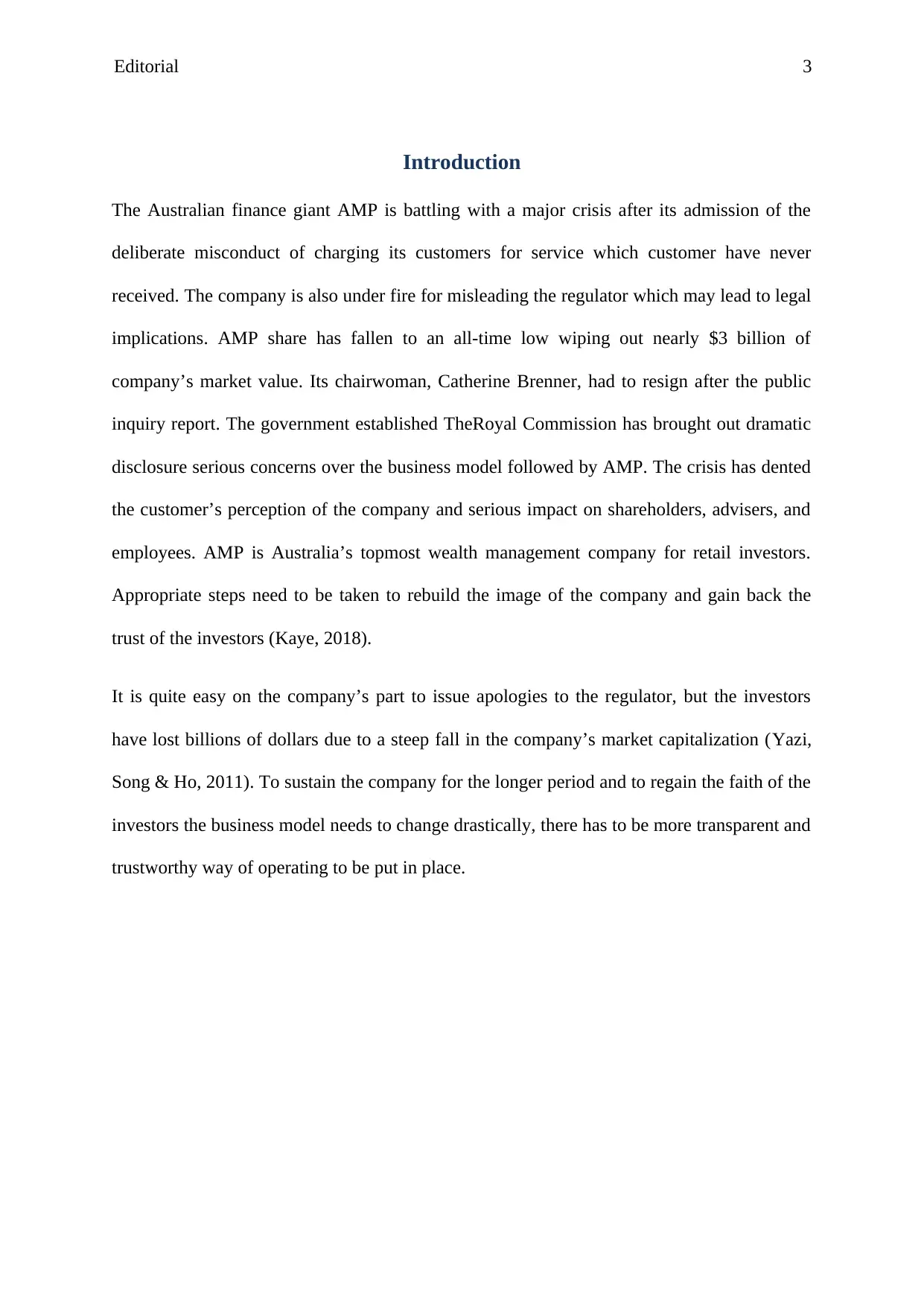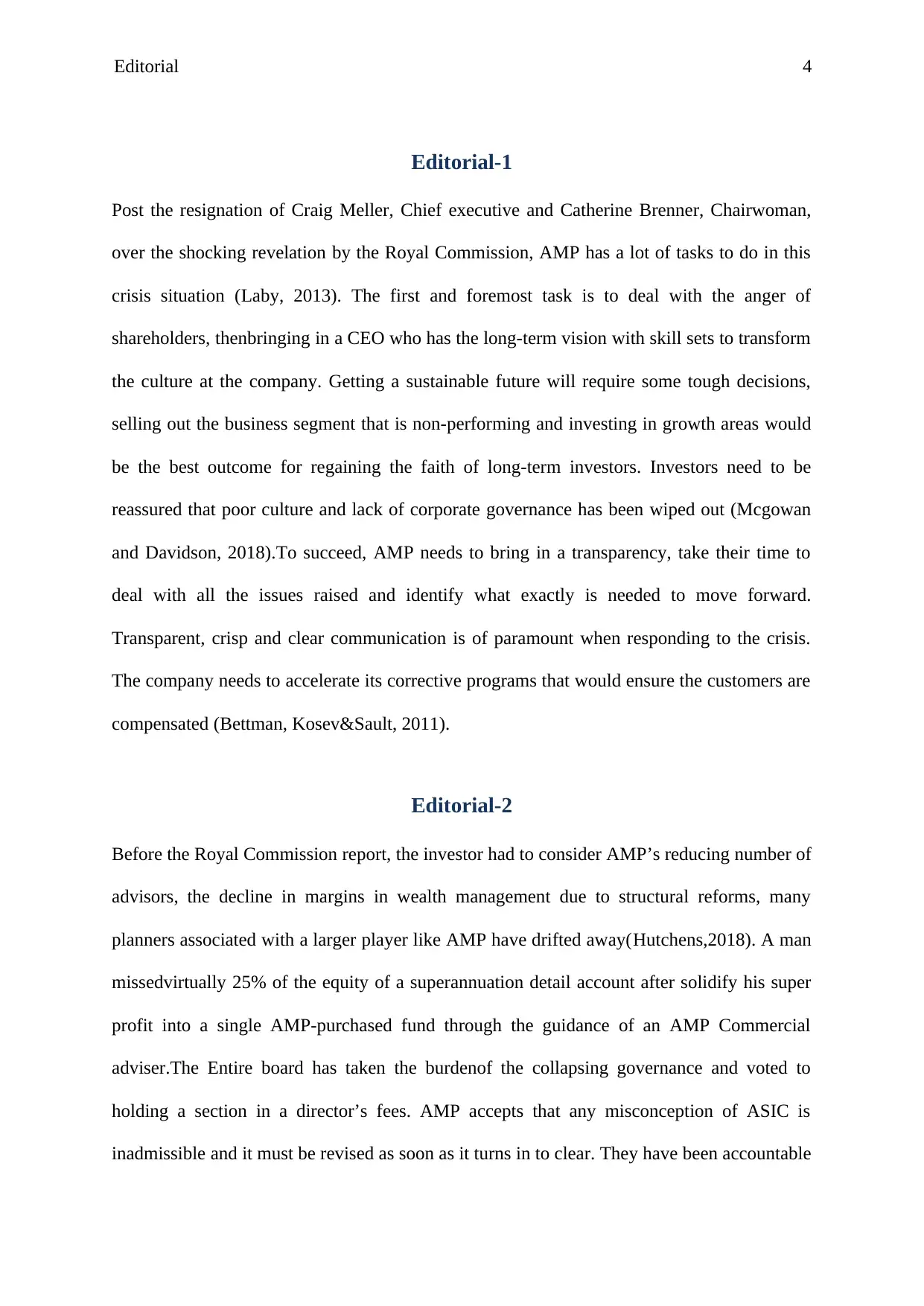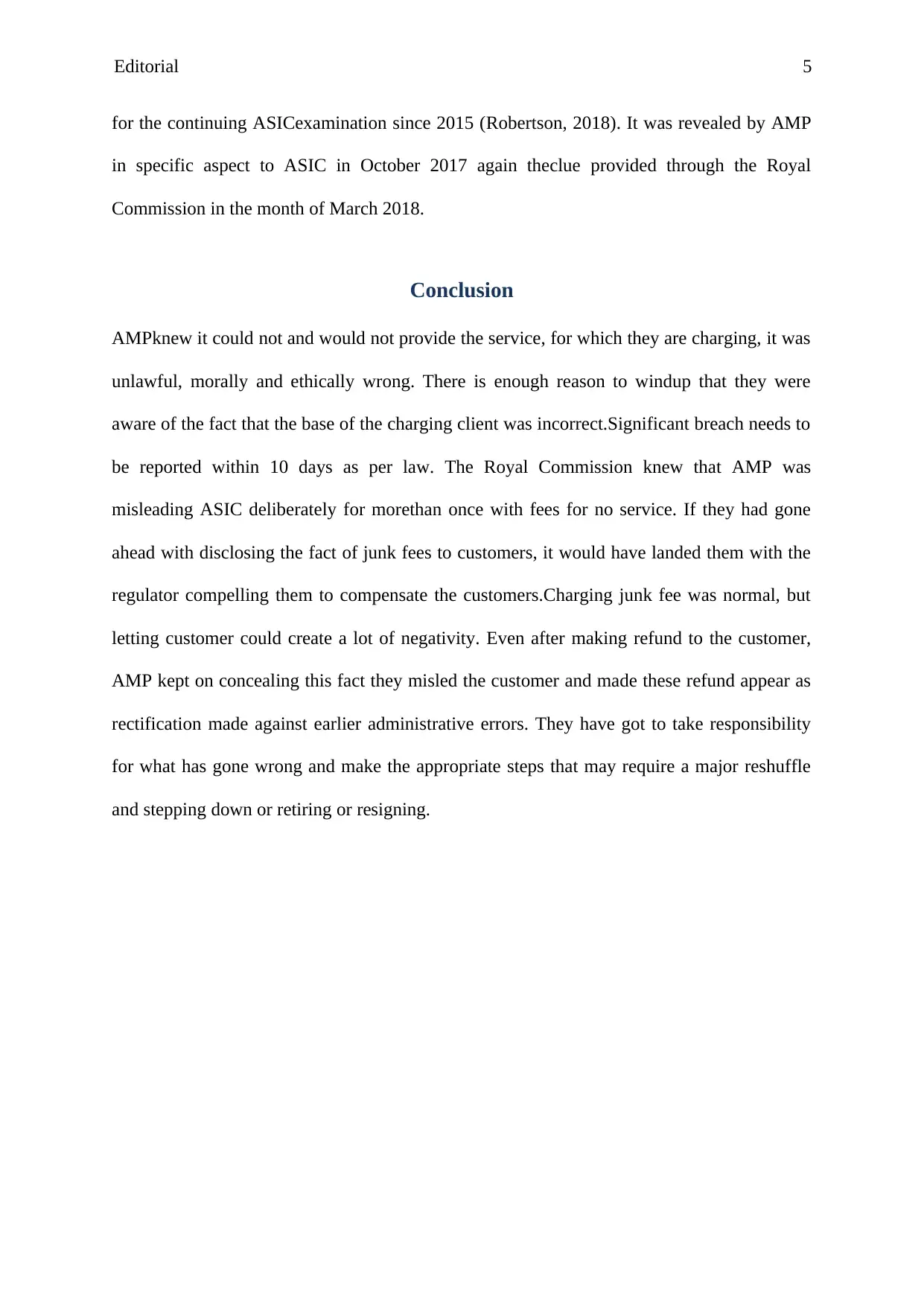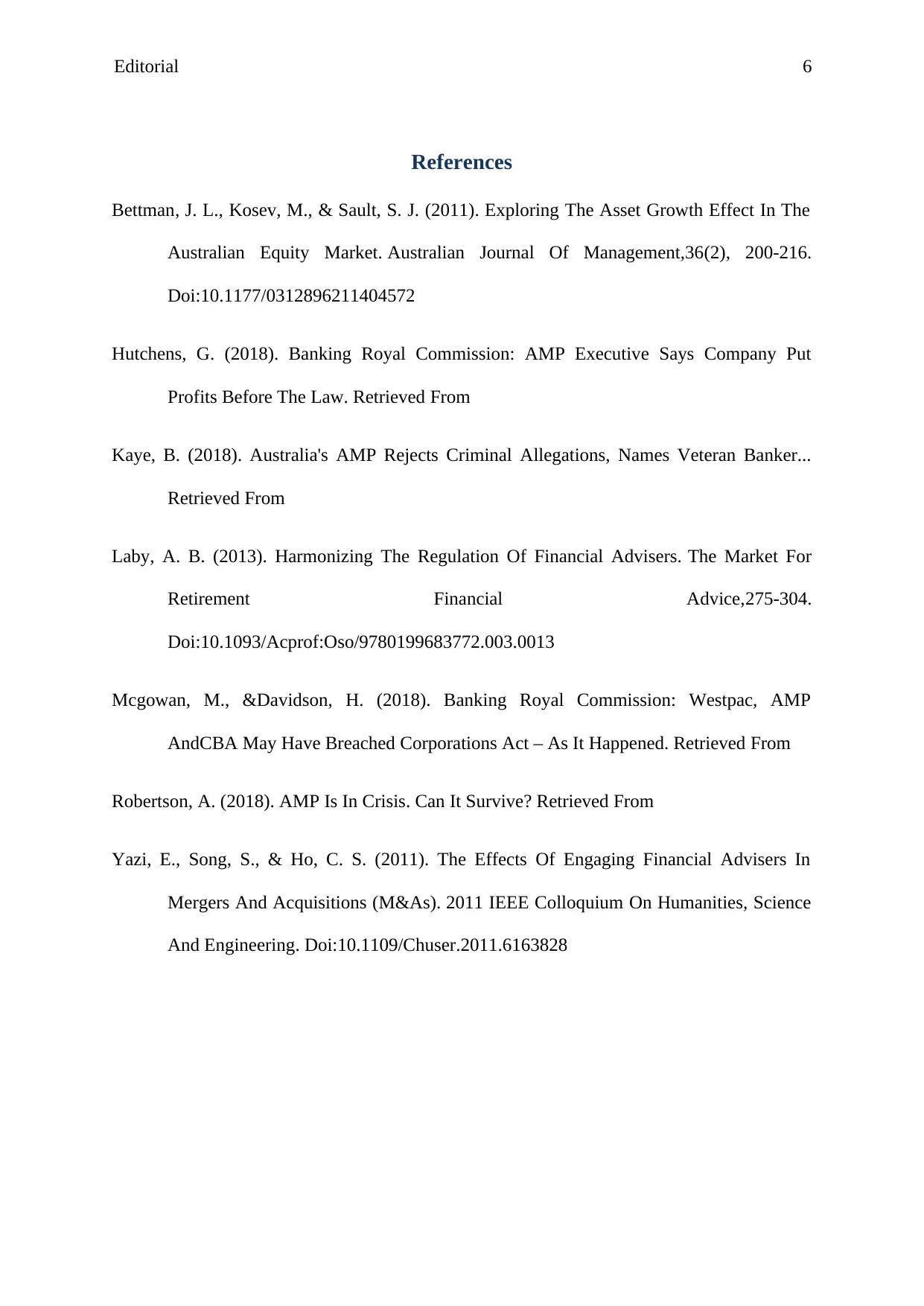Editorial Report: Analysis of AMP's Crisis and Strategic Recovery
VerifiedAdded on 2023/06/05
|6
|1068
|52
Report
AI Summary
This report provides an editorial analysis of the crisis faced by the Australian financial giant AMP. The report details the company's misconduct, including charging customers for services not rendered and misleading regulators, which led to a significant drop in share value and the resignation of key executives. The Royal Commission's findings revealed serious concerns about AMP's business model, impacting customer perception, shareholders, and employees. The editorial discusses the need for AMP to rebuild its image, regain investor trust, and implement drastic changes to its business model, emphasizing transparency and trustworthiness. It also addresses the tasks AMP must undertake to deal with shareholder anger, appoint a CEO with a long-term vision, and reassure investors about improved corporate governance. The report highlights the importance of transparent communication and accelerated corrective programs to compensate customers, along with the consequences of misleading regulators and the need for accountability and significant changes within the company.

Editorial 1
Report Name: Editorial
Student Name:
Student No:
AQF Level:
Word count: 750
Report Name: Editorial
Student Name:
Student No:
AQF Level:
Word count: 750
Paraphrase This Document
Need a fresh take? Get an instant paraphrase of this document with our AI Paraphraser

Editorial 2
Contents
Introduction................................................................................................................................3
Editorial-1..................................................................................................................................4
Editorial-2..................................................................................................................................4
Conclusion..................................................................................................................................5
References..................................................................................................................................6
Contents
Introduction................................................................................................................................3
Editorial-1..................................................................................................................................4
Editorial-2..................................................................................................................................4
Conclusion..................................................................................................................................5
References..................................................................................................................................6

Editorial 3
Introduction
The Australian finance giant AMP is battling with a major crisis after its admission of the
deliberate misconduct of charging its customers for service which customer have never
received. The company is also under fire for misleading the regulator which may lead to legal
implications. AMP share has fallen to an all-time low wiping out nearly $3 billion of
company’s market value. Its chairwoman, Catherine Brenner, had to resign after the public
inquiry report. The government established TheRoyal Commission has brought out dramatic
disclosure serious concerns over the business model followed by AMP. The crisis has dented
the customer’s perception of the company and serious impact on shareholders, advisers, and
employees. AMP is Australia’s topmost wealth management company for retail investors.
Appropriate steps need to be taken to rebuild the image of the company and gain back the
trust of the investors (Kaye, 2018).
It is quite easy on the company’s part to issue apologies to the regulator, but the investors
have lost billions of dollars due to a steep fall in the company’s market capitalization (Yazi,
Song & Ho, 2011). To sustain the company for the longer period and to regain the faith of the
investors the business model needs to change drastically, there has to be more transparent and
trustworthy way of operating to be put in place.
Introduction
The Australian finance giant AMP is battling with a major crisis after its admission of the
deliberate misconduct of charging its customers for service which customer have never
received. The company is also under fire for misleading the regulator which may lead to legal
implications. AMP share has fallen to an all-time low wiping out nearly $3 billion of
company’s market value. Its chairwoman, Catherine Brenner, had to resign after the public
inquiry report. The government established TheRoyal Commission has brought out dramatic
disclosure serious concerns over the business model followed by AMP. The crisis has dented
the customer’s perception of the company and serious impact on shareholders, advisers, and
employees. AMP is Australia’s topmost wealth management company for retail investors.
Appropriate steps need to be taken to rebuild the image of the company and gain back the
trust of the investors (Kaye, 2018).
It is quite easy on the company’s part to issue apologies to the regulator, but the investors
have lost billions of dollars due to a steep fall in the company’s market capitalization (Yazi,
Song & Ho, 2011). To sustain the company for the longer period and to regain the faith of the
investors the business model needs to change drastically, there has to be more transparent and
trustworthy way of operating to be put in place.
⊘ This is a preview!⊘
Do you want full access?
Subscribe today to unlock all pages.

Trusted by 1+ million students worldwide

Editorial 4
Editorial-1
Post the resignation of Craig Meller, Chief executive and Catherine Brenner, Chairwoman,
over the shocking revelation by the Royal Commission, AMP has a lot of tasks to do in this
crisis situation (Laby, 2013). The first and foremost task is to deal with the anger of
shareholders, thenbringing in a CEO who has the long-term vision with skill sets to transform
the culture at the company. Getting a sustainable future will require some tough decisions,
selling out the business segment that is non-performing and investing in growth areas would
be the best outcome for regaining the faith of long-term investors. Investors need to be
reassured that poor culture and lack of corporate governance has been wiped out (Mcgowan
and Davidson, 2018).To succeed, AMP needs to bring in a transparency, take their time to
deal with all the issues raised and identify what exactly is needed to move forward.
Transparent, crisp and clear communication is of paramount when responding to the crisis.
The company needs to accelerate its corrective programs that would ensure the customers are
compensated (Bettman, Kosev&Sault, 2011).
Editorial-2
Before the Royal Commission report, the investor had to consider AMP’s reducing number of
advisors, the decline in margins in wealth management due to structural reforms, many
planners associated with a larger player like AMP have drifted away(Hutchens,2018). A man
missedvirtually 25% of the equity of a superannuation detail account after solidify his super
profit into a single AMP-purchased fund through the guidance of an AMP Commercial
adviser.The Entire board has taken the burdenof the collapsing governance and voted to
holding a section in a director’s fees. AMP accepts that any misconception of ASIC is
inadmissible and it must be revised as soon as it turns in to clear. They have been accountable
Editorial-1
Post the resignation of Craig Meller, Chief executive and Catherine Brenner, Chairwoman,
over the shocking revelation by the Royal Commission, AMP has a lot of tasks to do in this
crisis situation (Laby, 2013). The first and foremost task is to deal with the anger of
shareholders, thenbringing in a CEO who has the long-term vision with skill sets to transform
the culture at the company. Getting a sustainable future will require some tough decisions,
selling out the business segment that is non-performing and investing in growth areas would
be the best outcome for regaining the faith of long-term investors. Investors need to be
reassured that poor culture and lack of corporate governance has been wiped out (Mcgowan
and Davidson, 2018).To succeed, AMP needs to bring in a transparency, take their time to
deal with all the issues raised and identify what exactly is needed to move forward.
Transparent, crisp and clear communication is of paramount when responding to the crisis.
The company needs to accelerate its corrective programs that would ensure the customers are
compensated (Bettman, Kosev&Sault, 2011).
Editorial-2
Before the Royal Commission report, the investor had to consider AMP’s reducing number of
advisors, the decline in margins in wealth management due to structural reforms, many
planners associated with a larger player like AMP have drifted away(Hutchens,2018). A man
missedvirtually 25% of the equity of a superannuation detail account after solidify his super
profit into a single AMP-purchased fund through the guidance of an AMP Commercial
adviser.The Entire board has taken the burdenof the collapsing governance and voted to
holding a section in a director’s fees. AMP accepts that any misconception of ASIC is
inadmissible and it must be revised as soon as it turns in to clear. They have been accountable
Paraphrase This Document
Need a fresh take? Get an instant paraphrase of this document with our AI Paraphraser

Editorial 5
for the continuing ASICexamination since 2015 (Robertson, 2018). It was revealed by AMP
in specific aspect to ASIC in October 2017 again theclue provided through the Royal
Commission in the month of March 2018.
Conclusion
AMPknew it could not and would not provide the service, for which they are charging, it was
unlawful, morally and ethically wrong. There is enough reason to windup that they were
aware of the fact that the base of the charging client was incorrect.Significant breach needs to
be reported within 10 days as per law. The Royal Commission knew that AMP was
misleading ASIC deliberately for morethan once with fees for no service. If they had gone
ahead with disclosing the fact of junk fees to customers, it would have landed them with the
regulator compelling them to compensate the customers.Charging junk fee was normal, but
letting customer could create a lot of negativity. Even after making refund to the customer,
AMP kept on concealing this fact they misled the customer and made these refund appear as
rectification made against earlier administrative errors. They have got to take responsibility
for what has gone wrong and make the appropriate steps that may require a major reshuffle
and stepping down or retiring or resigning.
for the continuing ASICexamination since 2015 (Robertson, 2018). It was revealed by AMP
in specific aspect to ASIC in October 2017 again theclue provided through the Royal
Commission in the month of March 2018.
Conclusion
AMPknew it could not and would not provide the service, for which they are charging, it was
unlawful, morally and ethically wrong. There is enough reason to windup that they were
aware of the fact that the base of the charging client was incorrect.Significant breach needs to
be reported within 10 days as per law. The Royal Commission knew that AMP was
misleading ASIC deliberately for morethan once with fees for no service. If they had gone
ahead with disclosing the fact of junk fees to customers, it would have landed them with the
regulator compelling them to compensate the customers.Charging junk fee was normal, but
letting customer could create a lot of negativity. Even after making refund to the customer,
AMP kept on concealing this fact they misled the customer and made these refund appear as
rectification made against earlier administrative errors. They have got to take responsibility
for what has gone wrong and make the appropriate steps that may require a major reshuffle
and stepping down or retiring or resigning.

Editorial 6
References
Bettman, J. L., Kosev, M., & Sault, S. J. (2011). Exploring The Asset Growth Effect In The
Australian Equity Market. Australian Journal Of Management,36(2), 200-216.
Doi:10.1177/0312896211404572
Hutchens, G. (2018). Banking Royal Commission: AMP Executive Says Company Put
Profits Before The Law. Retrieved From
Kaye, B. (2018). Australia's AMP Rejects Criminal Allegations, Names Veteran Banker...
Retrieved From
Laby, A. B. (2013). Harmonizing The Regulation Of Financial Advisers. The Market For
Retirement Financial Advice,275-304.
Doi:10.1093/Acprof:Oso/9780199683772.003.0013
Mcgowan, M., &Davidson, H. (2018). Banking Royal Commission: Westpac, AMP
AndCBA May Have Breached Corporations Act – As It Happened. Retrieved From
Robertson, A. (2018). AMP Is In Crisis. Can It Survive? Retrieved From
Yazi, E., Song, S., & Ho, C. S. (2011). The Effects Of Engaging Financial Advisers In
Mergers And Acquisitions (M&As). 2011 IEEE Colloquium On Humanities, Science
And Engineering. Doi:10.1109/Chuser.2011.6163828
References
Bettman, J. L., Kosev, M., & Sault, S. J. (2011). Exploring The Asset Growth Effect In The
Australian Equity Market. Australian Journal Of Management,36(2), 200-216.
Doi:10.1177/0312896211404572
Hutchens, G. (2018). Banking Royal Commission: AMP Executive Says Company Put
Profits Before The Law. Retrieved From
Kaye, B. (2018). Australia's AMP Rejects Criminal Allegations, Names Veteran Banker...
Retrieved From
Laby, A. B. (2013). Harmonizing The Regulation Of Financial Advisers. The Market For
Retirement Financial Advice,275-304.
Doi:10.1093/Acprof:Oso/9780199683772.003.0013
Mcgowan, M., &Davidson, H. (2018). Banking Royal Commission: Westpac, AMP
AndCBA May Have Breached Corporations Act – As It Happened. Retrieved From
Robertson, A. (2018). AMP Is In Crisis. Can It Survive? Retrieved From
Yazi, E., Song, S., & Ho, C. S. (2011). The Effects Of Engaging Financial Advisers In
Mergers And Acquisitions (M&As). 2011 IEEE Colloquium On Humanities, Science
And Engineering. Doi:10.1109/Chuser.2011.6163828
⊘ This is a preview!⊘
Do you want full access?
Subscribe today to unlock all pages.

Trusted by 1+ million students worldwide
1 out of 6
Your All-in-One AI-Powered Toolkit for Academic Success.
+13062052269
info@desklib.com
Available 24*7 on WhatsApp / Email
![[object Object]](/_next/static/media/star-bottom.7253800d.svg)
Unlock your academic potential
Copyright © 2020–2025 A2Z Services. All Rights Reserved. Developed and managed by ZUCOL.
